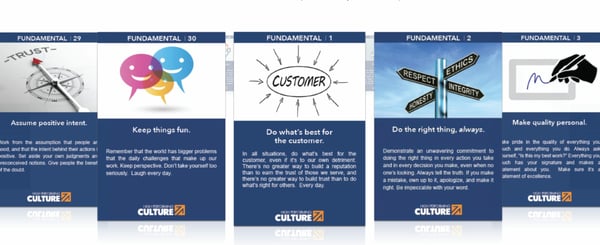
How to Write Effective Fundamentals
Two weeks ago, my colleague, HPC Senior Consultant Bill Kaiser, wrote about how to brainstorm the behaviors (we call them “Fundamentals”) that drive success in your organization, and why that’s important to do well if you want your culture to become a sustainable competitive advantage.
Today, I’ll talk about how to effectively write those behaviors so that they’re able to be taught and understood clearly by your people. Together, these two activities, brainstorming and writing behaviors, make up the first step in the Fundamentals System’s 8-step framework for driving a high performing culture.
Explanatory descriptions
Each Fundamental should be comprised of two written parts: a title and a description. The title is simply the name of the behavior you’ve identified as being essential to the success of your organization. Think something like “Honor Commitments.”
The description is a 2-4 sentence explanation of what you mean by that title. For example, at High Performing Culture we’ve described Honor Commitments by saying, “There’s no better way to earn people’s trust than to be true to your word. Do what you say you’re going to do, when you say you’re going to do it. This includes being on time for all phone calls, appointments, meetings, and promises. Allow extra time for surprises and delays, and don’t let these become excuses.”
Be action-oriented
As much as possible, stick to using “action statements” in the description rather than philosophical ones. The less you focus on what you believe, and the more you tell your people what you want them to actually do, the more clear, and thus more effective, your Fundamentals will be.
Don’t sweat the hypotheticals
As HPC Founder and CEO, David Friedman, writes in his book Culture by Design, the description can’t possibly cover every potential situation, scenario, or question. So don’t try to. Save all the other things you want to say and use them as teaching points for when your organization is practicing the behavior.
A few rules of thumb
- Every title should be an action. Remember, you want to define your culture in terms of behaviors, rather than values, because it’s so much easier to teach, coach, guide, and give people feedback on actions (behaviors) rather than ideas (values).
- Avoid “we” statements. While using “we” sounds inclusive, it actually weakens the level of accountability. Each Fundamental should charge the individual with taking some action, instead of relying on the collective.
- Picture a real person. It’s often helpful to picture someone who’s a great example of the Fundamental you’re writing a description of. This keeps you focused on describing the concrete actions they take, and away from becoming too vague.
- Keep it positive. It’s more effective to teach people what you want them to do than it is to describe what you don’t want them to do.
- Stick to one behavior at a time. While many Fundamentals are related to or help support one another, you have to be careful not to combine multiple ideas into one behavior. It can be challenging to navigate this gray area, so one test we’ve found helpful is to imagine what you’ll be teaching when practicing that specific Fundamental. If there’s so much content that you’d find it hard to cover it all, it’s likely that you’ve tried to combine too many behaviors into one Fundamental.
Now it’s time to teach
Defining the behaviors that drive success in your organization through the use of well-written titles and descriptions is a crucial component in driving a high performing culture. But as faithful readers of this blog know well, it’s only half the battle. Just as important is to set up a structured, systematic way to teach those behaviors to your people over and over and over again.
If you’d like to find out more about the Fundamentals System and our game-changing new app CultureWise, click the button below.

